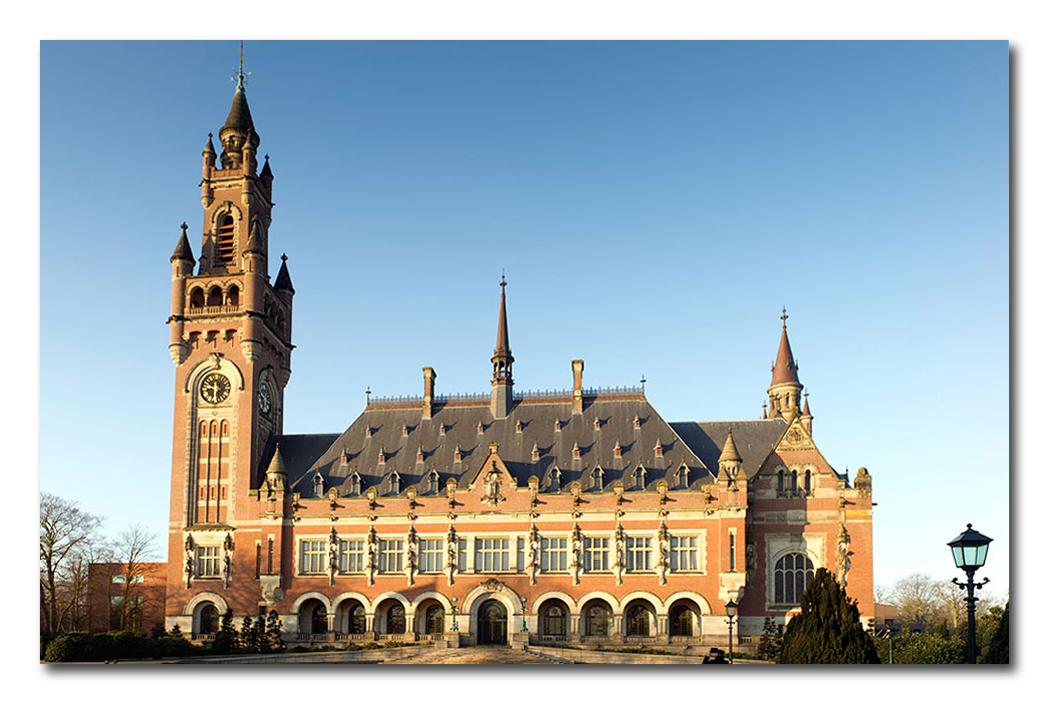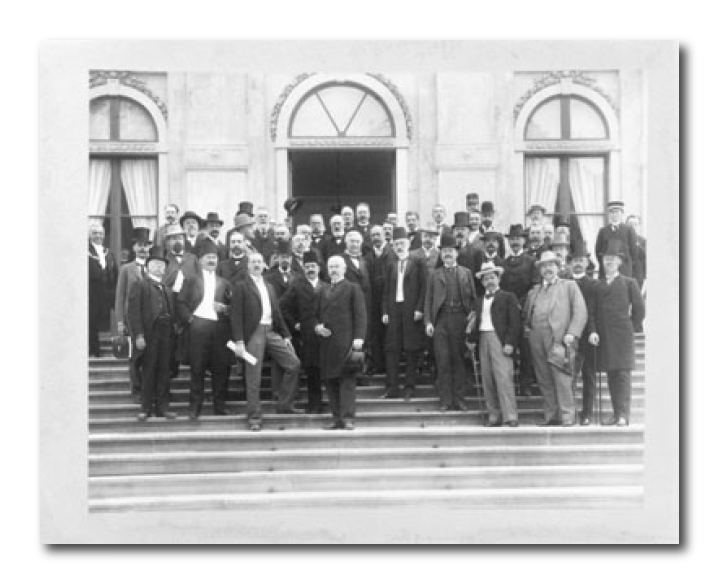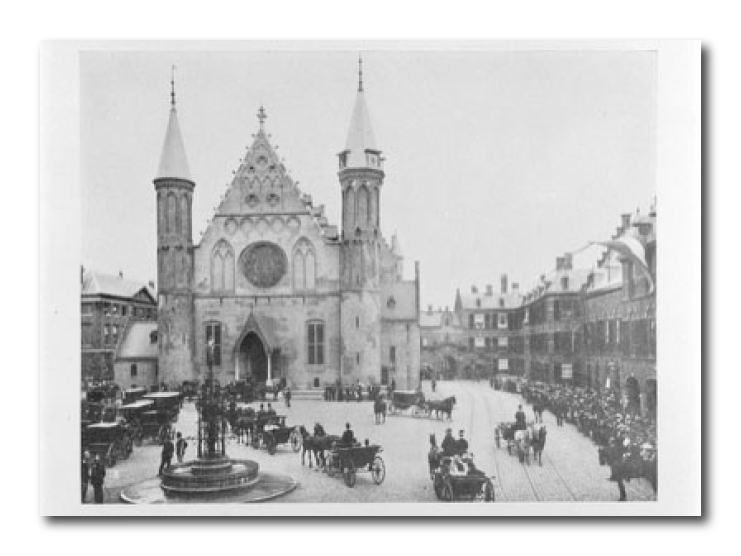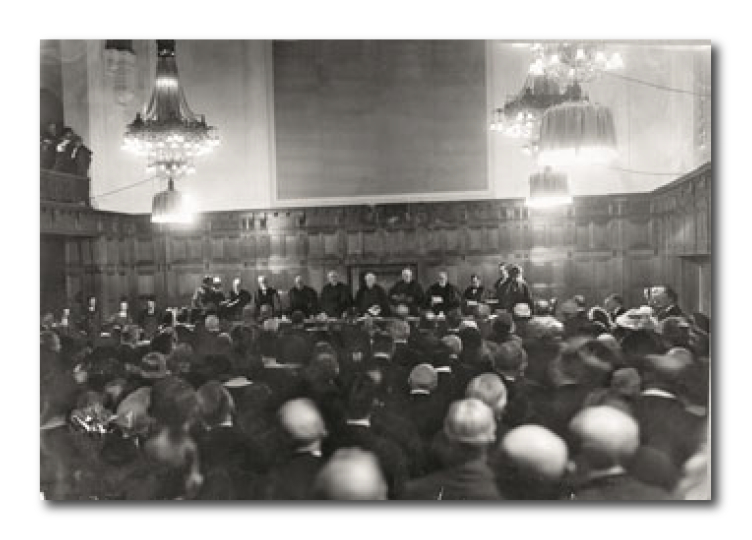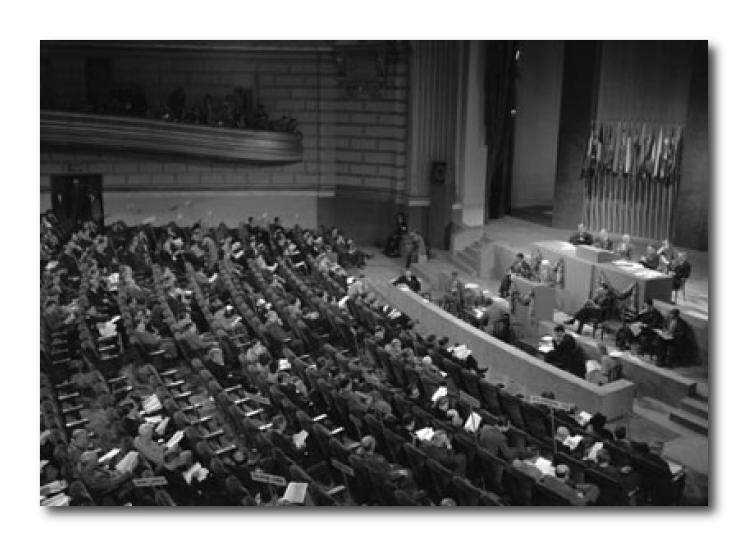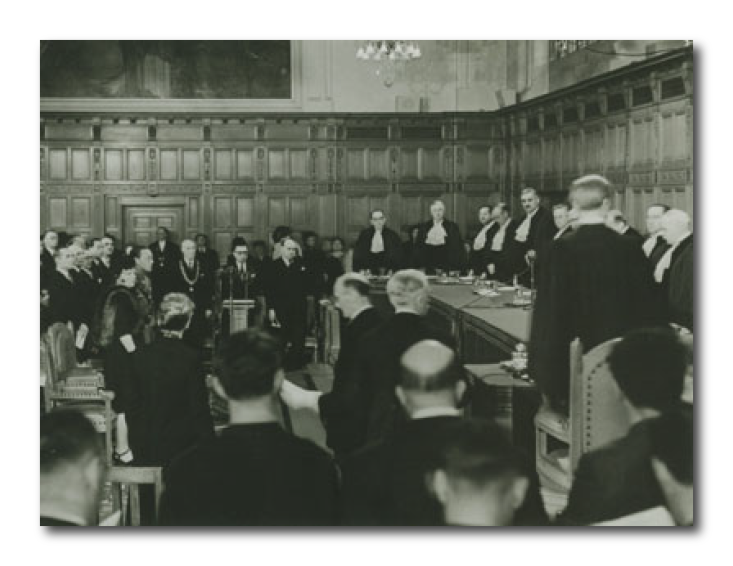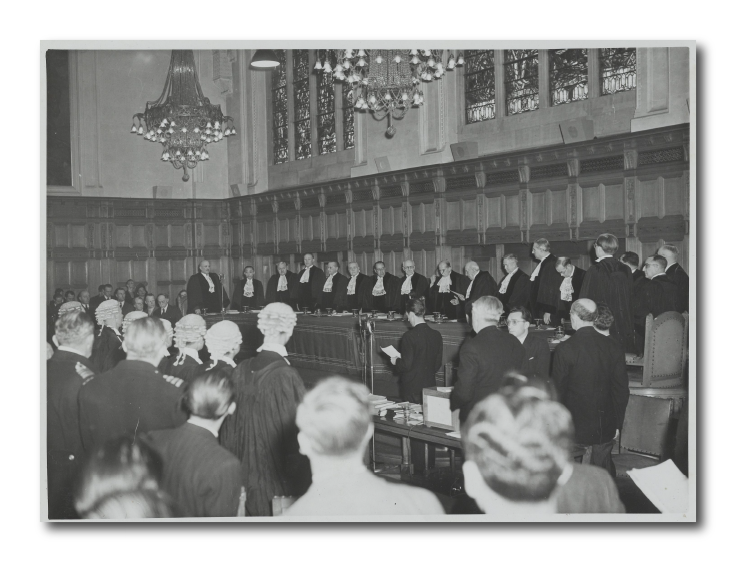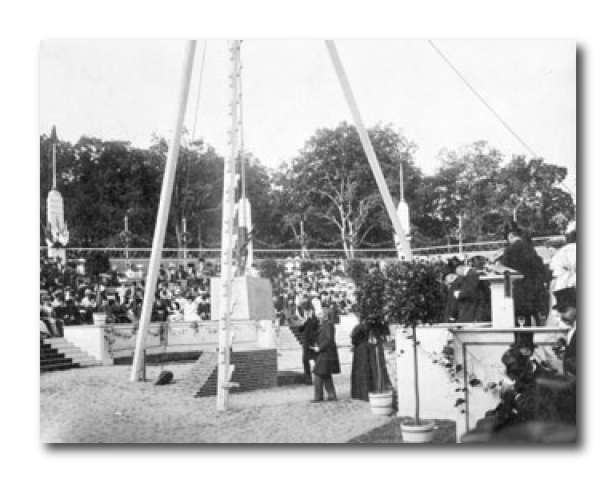Basic Toolkit
History
- ORIGINS
- 1899
- 1907
- 1920
- 1922
- 1945
- 1946
- 1947
- 2023

Composition of the court
President Nawaf Salam — Lebanon
Member of the Court since 6 February 2018;
President as from 6 February 2024
The President and Vice-President are elected by the Members of the Court every three years by secret ballot. The election is held on the date of Court’s triennial renewal or shortly thereafter. An absolute majority is required and there are no conditions of nationality. The President and Vice-President may be re-elected. The President presides at all meetings of the Court; he or she directs its work and supervises its administration, with the assistance of a Budgetary and Administrative Committee and various other committees, all composed of Members of the Court. During judicial deliberations, the President has a casting vote in the event of votes being tied. The Vice-President replaces the President in his or her absence, in the event of his or her inability to perform his or her duties, or in the event of a vacancy in the presidency. In the absence of the Vice-President, this role falls to the senior judge.
President Nawaf Salam — Lebanon.
Member of the Court since 6 February 2018;
President as from 6 February 2024
The President and Vice-President are elected by the Members of the Court every three years by secret ballot. The election is held on the date of Court’s triennial renewal or shortly thereafter. An absolute majority is required and there are no conditions of nationality. The President and Vice-President may be re-elected. The President presides at all meetings of the Court; he or she directs its work and supervises its administration, with the assistance of a Budgetary and Administrative Committee and various other committees, all composed of Members of the Court. During judicial deliberations, the President has a casting vote in the event of votes being tied. The Vice-President replaces the President in his or her absence, in the event of his or her inability to perform his or her duties, or in the event of a vacancy in the presidency. In the absence of the Vice-President, this role falls to the senior judge.
Vice-President Julia Sebutinde — Uganda
Member of the Court since 6 February 2012;
re-elected as from 6 February 2021;
Vice-President as from 6 February 2024
The President and Vice-President are elected by the Members of the Court every three years by secret ballot. The election is held on the date of Court’s triennial renewal or shortly thereafter. An absolute majority is required and there are no conditions of nationality. The President and Vice-President may be re-elected. The President presides at all meetings of the Court; he or she directs its work and supervises its administration, with the assistance of a Budgetary and Administrative Committee and various other committees, all composed of Members of the Court. During judicial deliberations, the President has a casting vote in the event of votes being tied. The Vice-President replaces the President in his or her absence, in the event of his or her inability to perform his or her duties, or in the event of a vacancy in the presidency. In the absence of the Vice-President, this role falls to the senior judge.
Judge Peter Tomka — Slovakia
Member of the Court since 6 February 2003;
re-elected as from 6 February 2012 and as from 6 February 2021;
Vice-President of the Court from 6 February 2009 to 5 February 2012;
President of the Court from 6 February 2012 to 5 February 2015
The International Court of Justice is composed of 15 Judges (or Members) elected to nine-year terms of office by the United Nations General Assembly and the Security Council. In order to ensure a degree of continuity, one third of the Court is elected every three years. Once elected, a Member of the Court is a delegate neither of the government of his or her own country nor of that of any other State. The Court may not include more than one national of the same State. Judges are eligible for re-election.
Judge Ronny Abraham — France
Member of the Court since 14 February 2005;
re-elected as from 5 February 2009 and as from 6 February 2018;
President of the Court from 5 February 2015 to 5 February 2018
The International Court of Justice is composed of 15 Judges (or Members) elected to nine-year terms of office by the United Nations General Assembly and the Security Council. In order to ensure a degree of continuity, one third of the Court is elected every three years. Once elected, a Member of the Court is a delegate neither of the government of his or her own country nor of that of any other State. The Court may not include more than one national of the same State. Judges are eligible for re-election.
Judge Abdulqawi Ahmed Yusuf — Somalia
Member of the Court since 6 February 2009;
re-elected as from 6 February 2018;
Vice-President of the Court from 6 February 2015 to 5 February 2018;
President of the Court from 6 February 2018 to 8 February 2021
The International Court of Justice is composed of 15 Judges (or Members) elected to nine-year terms of office by the United Nations General Assembly and the Security Council. In order to ensure a degree of continuity, one third of the Court is elected every three years. Once elected, a Member of the Court is a delegate neither of the government of his or her own country nor of that of any other State. The Court may not include more than one national of the same State. Judges are eligible for re-election.
Judge Xue Hanqin — China
Member of the Court since 29 June 2010;
re-elected as from 6 February 2012 and as from 6 February 2021;
Vice-President of the Court from 6 February 2018 to 8 February 2021
The International Court of Justice is composed of 15 Judges (or Members) elected to nine-year terms of office by the United Nations General Assembly and the Security Council. In order to ensure a degree of continuity, one third of the Court is elected every three years. Once elected, a Member of the Court is a delegate neither of the government of his or her own country nor of that of any other State. The Court may not include more than one national of the same State. Judges are eligible for re-election.
Judge Dalveer Bhandari — India
Member of the Court since 27 April 2012,
re-elected as from 6 February 2018
The International Court of Justice is composed of 15 Judges (or Members) elected to nine-year terms of office by the United Nations General Assembly and the Security Council. In order to ensure a degree of continuity, one third of the Court is elected every three years. Once elected, a Member of the Court is a delegate neither of the government of his or her own country nor of that of any other State. The Court may not include more than one national of the same State. Judges are eligible for re-election.
Judge Iwasawa Yuji — Japan
Member of the Court since 22 June 2018;
re-elected as from 6 February 2021
The International Court of Justice is composed of 15 Judges (or Members) elected to nine-year terms of office by the United Nations General Assembly and the Security Council. In order to ensure a degree of continuity, one third of the Court is elected every three years. Once elected, a Member of the Court is a delegate neither of the government of his or her own country nor of that of any other State. The Court may not include more than one national of the same State. Judges are eligible for re-election.
Judge Georg Nolte — Germany
Member of the Court since 6 February 2021
The International Court of Justice is composed of 15 Judges (or Members) elected to nine-year terms of office by the United Nations General Assembly and the Security Council. In order to ensure a degree of continuity, one third of the Court is elected every three years. Once elected, a Member of the Court is a delegate neither of the government of his or her own country nor of that of any other State. The Court may not include more than one national of the same State. Judges are eligible for re-election.
Judge Hilary Charlesworth — Australia
Member of the Court since 5 November 2021;
re-elected as from 6 February 2024
The International Court of Justice is composed of 15 Judges (or Members) elected to nine-year terms of office by the United Nations General Assembly and the Security Council. In order to ensure a degree of continuity, one third of the Court is elected every three years. Once elected, a Member of the Court is a delegate neither of the government of his or her own country nor of that of any other State. The Court may not include more than one national of the same State. Judges are eligible for re-election.
Judge Judge Leonardo Nemer Caldeira Brant — Brazil
Member of the Court since 4 November 2022
The International Court of Justice is composed of 15 Judges (or Members) elected to nine-year terms of office by the United Nations General Assembly and the Security Council. In order to ensure a degree of continuity, one third of the Court is elected every three years. Once elected, a Member of the Court is a delegate neither of the government of his or her own country nor of that of any other State. The Court may not include more than one national of the same State. Judges are eligible for re-election.
Judge Juan Manuel Gómez Robledo — Mexico
Member of the Court since 6 February 2024
The International Court of Justice is composed of 15 Judges (or Members) elected to nine-year terms of office by the United Nations General Assembly and the Security Council. In order to ensure a degree of continuity, one third of the Court is elected every three years. Once elected, a Member of the Court is a delegate neither of the government of his or her own country nor of that of any other State. The Court may not include more than one national of the same State. Judges are eligible for re-election.
Judge Sarah H. Cleveland — United States of America
Member of the Court since 6 February 2024
The International Court of Justice is composed of 15 Judges (or Members) elected to nine-year terms of office by the United Nations General Assembly and the Security Council. In order to ensure a degree of continuity, one third of the Court is elected every three years. Once elected, a Member of the Court is a delegate neither of the government of his or her own country nor of that of any other State. The Court may not include more than one national of the same State. Judges are eligible for re-election.
Judge Bogdan-Lucian Aurescu — Romania
Member of the Court since 6 February 2024
The International Court of Justice is composed of 15 Judges (or Members) elected to nine-year terms of office by the United Nations General Assembly and the Security Council. In order to ensure a degree of continuity, one third of the Court is elected every three years. Once elected, a Member of the Court is a delegate neither of the government of his or her own country nor of that of any other State. The Court may not include more than one national of the same State. Judges are eligible for re-election.
Judge Dire Tladi — South Africa
Member of the Court since 6 February 2024
The International Court of Justice is composed of 15 Judges (or Members) elected to nine-year terms of office by the United Nations General Assembly and the Security Council. In order to ensure a degree of continuity, one third of the Court is elected every three years. Once elected, a Member of the Court is a delegate neither of the government of his or her own country nor of that of any other State. The Court may not include more than one national of the same State. Judges are eligible for re-election.
Mr. Philippe Gautier - Belgium
Registrar since 1 August 2019
The Court appoints its Registrar from among candidates proposed by Members of the Court. He or she is elected for a term of seven years and may be re-elected. The Deputy-Registrar, who is elected in the same way as the Registrar, assists the Registrar and acts as Registrar in the latter’s absence.
The Registry is the permanent administrative secretariat of the Court. It is accountable to the Court alone. Since the Court is both a court of justice and an international organization, the Registry’s tasks are not only those of a service helping in the administration of justice - with Sovereign States as litigants - but also those of an international secretariat. Its activities are judicial and diplomatic, as well as administrative.
Click on the silhouettes to find out more about the composition of the Court.
Work of the Court
The ICJ, the principal judicial organ of the United Nations, acts as a world court. It may entertain two types of cases: legal disputes between States submitted to it by those States (contentious proceedings) and requests for advisory opinions on legal questions referred to it by the United Nations organs, its specialized agencies or affiliated organizations (advisory proceedings).
In the exercise of its jurisdiction in contentious cases, the ICJ settles disputes of a legal nature that are submitted to it by States in accordance with international law. An international legal dispute can be defined as a disagreement on a question of law or fact, a conflict, or a clash of legal views or interests.
The procedure consists of two parts: written and oral. They are concluded by the deliberation of the Court, after which a decision is issued in a public sitting.
Only States can be parties to contentious cases. Moreover, the Court can only deal with a dispute when the States concerned have recognized its jurisdiction.
The advisory procedure is open to only the United Nations organs, including the General Assembly and the Security Council, as well as the 16 specialized agencies of the United Nations family or related organizations. Advisory proceedings begin with the filing of a written request for an advisory opinion addressed to the Registrar by the United Nations Secretary-General or the director or secretary-general of the entity requesting the opinion. A few days after the request has been filed, the Court draws up a list of the States and international organizations that are likely to be able to furnish information on the legal question before the Court. Similar to contentious cases, advisory proceedings of two parts: written and oral. They are concluded by the deliberation of the Court, after which the Court issues its advisory opinion in a public sitting.
Unlike the judgments rendered by the Court in contentious cases, the advisory opinions it gives are not binding, but they do carry great legal weight and moral authority.

The Court was established in pursuance of one of the United Nation’s primary purposes, namely to maintain international peace and security by pacific means and in conformity with international law. The ICJ also plays a vital role within the framework of Sustainable Development Goal 16 concerning the promotion of peace, justice, and strong and effective institutions.
Seat of the Court
Other Organizations
Members of the ICJ during court hearings held in December 2019 (ICJ/UN photo)

